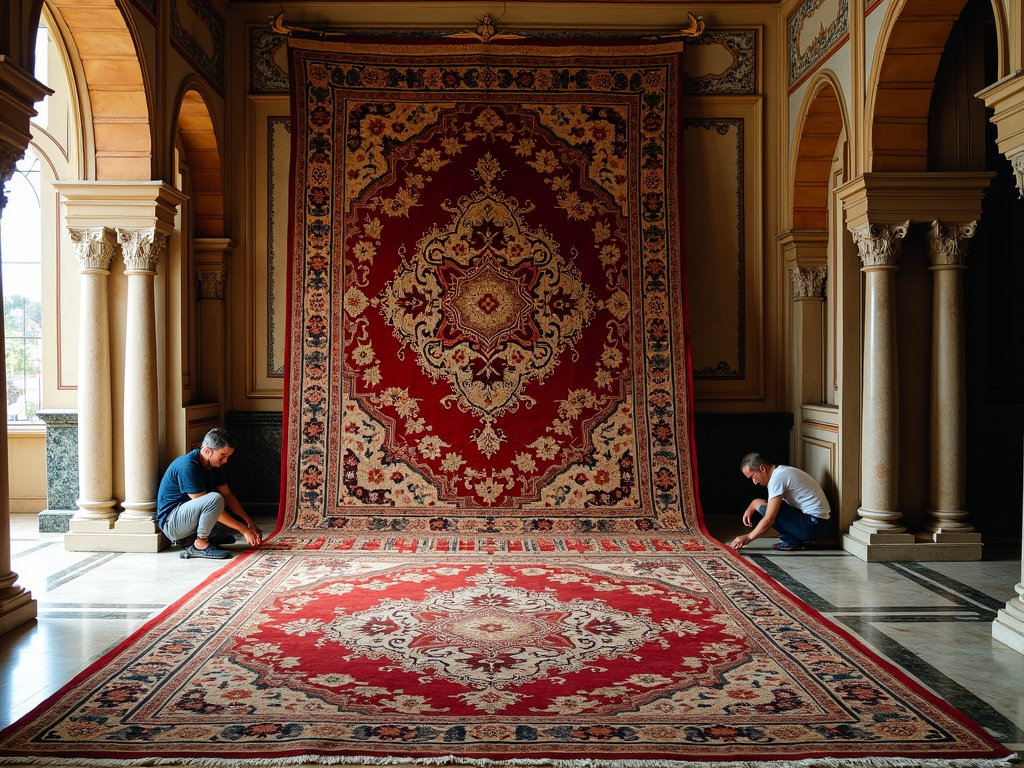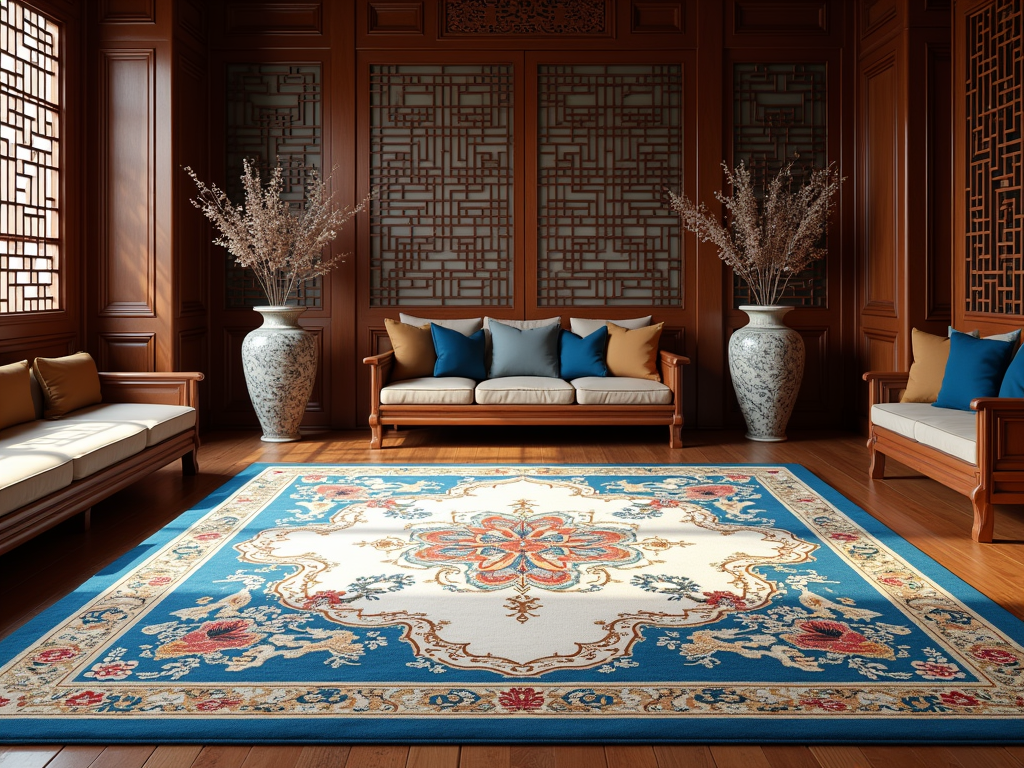
Persia’s Rug-Making Legacy
Persia’s rug-making legacy stretches back 2,500 years to the Achaemenid Empire. Each major weaving center in modern Iran – Tabriz, Kashan, Isfahan, and others – creates carpets with distinct patterns, colors, and techniques that define luxury rug production worldwide.
Key Takeaways
- Persian rugs date to the 5th century BC, proven by the Pazyryk carpet discovery.
- Each Iranian weaving center crafts rugs with signature designs and color palettes.
- Artisans hand-knot traditional Persian rugs using natural materials and authentic dye methods.
- This ancient craft has stayed relevant for 2,000 years while meeting current market needs.
- Persian rugs blend art with cultural heritage – every carpet shares a unique story through its patterns.
Regional Styles and Artisan Techniques
I focus on how each region’s distinctive style reflects local traditions and artistic preferences. The techniques passed down through generations create carpets that merge historical authenticity with contemporary appeal. Persian rug making demonstrates the endurance of skilled craftsmanship, as artisans continue to produce masterpieces that honor their cultural legacy.
Materials and Quality
Weavers select premium wool, silk, and cotton, then apply time-tested dyeing methods to create rich, lasting colors. The intricate patterns require months or years of careful hand-knotting. This dedication to quality and artistry explains why Persian rugs remain the standard for excellence in carpet making.
The Legacy of Persian Rugs: A 2,500-Year Tradition of Excellence
Ancient Origins and Historical Significance
I can confidently say that Persia, now known as Iran, stands as the most celebrated hub of rug making in history. The craft of Persian rug weaving techniques started during the Achaemenid Empire (553-330 BC), setting standards that still influence modern carpet making. The remarkable discovery of the Pazyryk carpet from the 5th century BC, which experts believe is Persian, proves this rich heritage.
Distinguished Weaving Centers and Their Impact
The reputation of authentic Persian rugs stems from six major weaving centers, each with their unique characteristics. These centers include Tabriz, known for its precision in geometric patterns; Kashan, famous for its rich reds and blues; and Isfahan, celebrated for its intricate floral designs. The cities of Kerman, Heriz, and Mashhad also contribute significantly to this artistic legacy.
Persian rugs have become the global benchmark for quality carpet making. Here’s what makes them special:
- Hand-knotted construction using natural materials
- Distinctive regional patterns and color combinations
- Traditional dyeing techniques passed down through generations
- Complex symmetrical designs featuring cultural motifs
The origin of Persian rug making isn’t just about creating floor coverings – it’s an art form that has shaped the entire carpet industry. Each rug tells a story through its patterns, colors, and weaving techniques, making these pieces true cultural artifacts. The dedication to maintaining traditional methods while adapting to modern demands has kept Persian rugs at the forefront of luxury floor coverings for over two millennia.
Turkish Rugs: Where East Meets West
Turkey’s carpet crafting legacy stretches back to the 13th century, making it one of the world’s most important rug-producing nations. Turkish rug making history showcases a rich tradition of artistry and skill.
Historical Significance
The excellence of Turkish rugs caught the attention of notable historical figures. Marco Polo, in his travel logs around 1300, specifically highlighted the exceptional quality of Turkish carpets. I’ve found that what makes Turkish rugs distinct from other varieties is their bold geometric patterns and the signature symmetrical Turkish (Ghiordes) knot technique.
Famous Rug-Making Centers
Several Turkish regions have earned recognition for their unique rug-making styles. The city of Konya produces rugs known for their tribal designs and rich colors. Usak’s weavers create carpets with medallion patterns that have influenced European art. In Bergama, you’ll find rugs that feature striking geometric motifs and natural dyes.
The most prestigious Turkish rugs come from Hereke, where master weavers craft incredibly detailed pieces using silk. These exceptional carpets were so highly regarded that Ottoman sultans specifically commissioned them for their palaces. The traditional rug making techniques used in Hereke continue to set the standard for luxury carpets today.
Key features that make Hereke rugs stand out include:
- Double-knotted construction for enhanced durability
- Intricate floral and geometric patterns
- High knot count reaching up to 3,500 knots per square inch
- Use of precious materials like silk and gold thread
- Traditional Ottoman-inspired designs

The Nomadic Art of Central Asian Carpets
Central Asia’s master weavers, particularly those from the historic Turkmen tribal regions, have created some of the most stunning carpets in existence. The Tekke, Yomut, Ersari, and Saryk tribes stand out for their exceptional weaving skills and unique tribal emblems called ‘guls‘ – geometric patterns that serve as their signature designs.
Distinctive Features and Tribal Influences
These Central Asian carpets showcase rich colors dominated by deep reds, browns, and blacks, setting them apart from other regional styles. The nomadic lifestyle of these tribes has shaped their carpet-making techniques, with designs reflecting their mobile way of life and available materials. I’ve noticed how Afghan rug makers have borrowed heavily from both Turkmen and Baluch traditions, creating their own unique blend of styles.
The region’s carpet-making legacy extends beyond traditional pile rugs. Here’s what makes each area special:
- Uzbekistan excels in creating detailed Suzani embroideries
- Kazakhstan specializes in shyrdak, a distinctive felt-making tradition
- Turkmen tribes focus on portable, durable wool carpets with their signature guls
The ancient craft of rug making in Central Asia continues to thrive, with each tribe maintaining its distinctive patterns and techniques that have been passed down through generations.

Royal Carpets of the Mughal Empire
The Rise of Indian Carpet Making
I can trace the golden age of Indian carpet weaving back to the mighty Mughal Empire. While ancient rug making traditions span across Asia, India’s contribution to this craft took a remarkable turn during the 16th century. The Mughal emperors, particularly Akbar, Jahangir, and Shah Jahan, transformed carpet weaving from a local craft into a sophisticated art form by establishing royal workshops across their territories.
Distinctive Features and Major Centers
The unique characteristics of Indian rugs set them apart from other styles. Mughal carpets showcase stunning floral patterns that mix Persian influences with Indian artistic elements. These carpets often feature:
- Intricate botanical motifs with realistic flower representations
- Rich jewel tones combined with subtle earth colors
- Detailed borders filled with geometric patterns
- Fine wool and silk materials with high knot counts
The craft of Indian rug making flourished in several key centers. Agra, the city of the Taj Mahal, became famous for its thick, plush carpets. Jaipur’s weavers mastered the art of creating geometric designs with striking color combinations. However, Kashmir stands out as the crown jewel of Indian carpet weaving. The region’s artisans craft exceptional silk and pashmina rugs, using techniques passed down through generations. These Kashmir rugs are particularly prized for their softness and intricate detailing, making them some of the most sought-after pieces in the world.
The legacy of Mughal carpet weaving continues to influence modern rug design, with many contemporary Indian artisans still drawing inspiration from these historical masterpieces. Each piece tells a story of artistic excellence and imperial grandeur that shaped India’s rug-making tradition.

Ancient Artistry of Chinese Carpets
Legacy of Imperial Craftsmanship
While many associate carpet making with traditional rug producing regions, China’s remarkable contribution to this art form spans back 2,000 years. The nation’s rich textile heritage has shaped how I view the development of carpet making as an art form. Chinese rugs stand apart from other traditional carpet styles through their distinctive use of symbolism and cultural motifs.
The Ningxia region, particularly celebrated for its classical Chinese rugs, has maintained its reputation as a hub of exceptional carpet craftsmanship. These carpets showcase a unique blend of wool and silk, materials that create stunning visual effects and ensure durability. The signature blue and white color combinations found in antique Chinese carpets have become highly sought-after by collectors and interior designers alike.
Distinctive Design Elements
The artistry of traditional Chinese rug making is evident in its iconic motifs. I’ve found that these carpets often tell stories through their imagery, featuring:
- Imperial dragons symbolizing power and prosperity
- Birds representing freedom and spiritual connection
- Intricate floral patterns showcasing natural beauty
- Landscape scenes depicting mountains and waterways
- Geometric borders blending simplicity with sophistication
Traditional Chinese carpet designs strike a perfect balance between artistic expression and practical function. Their classical approach to design relies on clean lines and uncluttered compositions, creating pieces that feel both timeless and modern. This simplistic yet refined aesthetic has helped Chinese rugs maintain their appeal across generations, making them versatile additions to various interior styles.

Sources:
Oriental Rugs: A Comprehensive Guide – Murray L. Eiland Jr. and Murray Eiland III
Rugs & Carpets: From the Caucasus and Beyond – Ian Bennett
Carpets – F.R. Martin
The World of Carpets – Angelo, Montenegro and Radaelli
